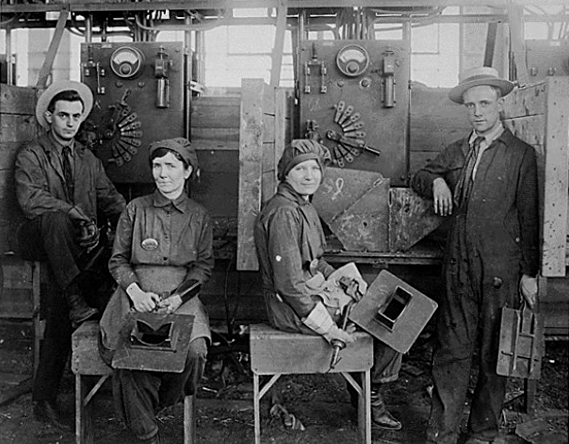The First Women Industrial Welders Weren’t Rosies
Lincoln Cushing
This was first published in Kaiser Permanente's A History of Total Health blog 1/22/2019; it was unpublished per corporate communications policy and now republished 1/8/2024.

The nation is at war. A desolate stretch of waterfront is rapidly turned into a state-of-the-art shipyard, producing vessels for the U.S. Navy. The huge demand for labor runs deep, and, for the first time ever, women are hired to perform electric welding on ships for the Navy.
The Kaiser Richmond shipyards, 1942? No.
Hog Island, just outside of Philadelphia, 1918.
Although the powerful role of women on the World War II U.S. home front is well-known, at least partly through the iconic Rosie the Riveter, the pioneering role of women 24 years earlier is all but forgotten.
Sarah A. Erwin was the first woman in the United States to be engaged in industrial ship construction. She applied for a job at the Hog Island yard in September 1918. The managers put her in the electric welding department as a test of women’s abilities in this craft, where she did so well that the jobs were eventually opened to 30 more women. The shipyard provided paid training, and the women handled fixing bad welds in the plate and angle shop. Erwin was followed by Anna Kenneste (or Aina Kannisto) and Mary Dunn. The women had to be between the ages of 24 and 35 and be “healthy and robust.”
The thousand-acre Hog Island yards were under the jurisdiction of the United States Shipping Board Emergency Fleet Corporation, had 50 shipways, and employed as many as 35,000 men and nearly 700 women. Although only a handful of women worked as welders, other non-clerical positions included such jobs as drivers of “high power touring cars.” The newspaper want ads noted that, despite requiring the ability to change tires and perform engine cranking, “Women of poise and character only wanted.”
Like the World War II “Rosie the Riveter” and “Wendy the Welder” pioneers, the women welders at Hog Island were proud of their accomplishments. A November 30, 1918, article in the Pittsburgh Press quoted Kannisto as saying, “I would rather do electric welding than sell ribbons behind a counter or work in an office. The pay is better, and you have more independence. This war has driven out of the heads of many women the mistaken idea that they are only fit to look pretty and flatter their husbands.”
Alas, a generation later, on the other side of the country in the Kaiser shipyards, women would again have to blaze the same path. Yet Erwin’s contribution to the advancement of women in the workforce cannot be forgotten.
Special thanks to History of Total Health reader Frank Trezza who pointed out this lost history.
-30-
Images:
“Sarah A. Erwin and Aina Kannisto at work at their welding machines.” The Baltimore Sun, 12/15/1918
Newspaper ad for drivers at Hog Island shipyard, 10/5/1918.
Return to Docs Populi / Documents for the Public